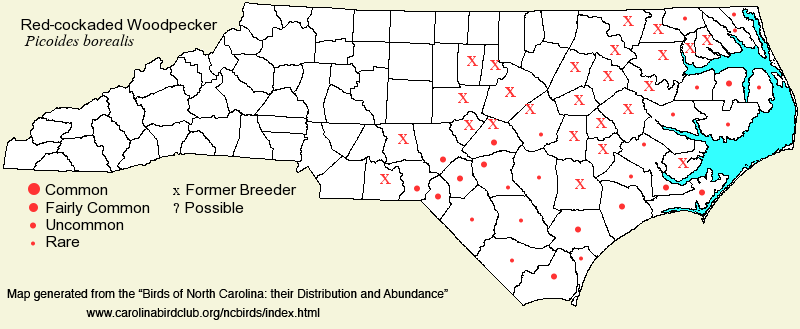 |  |
|
Red-cockaded Woodpecker - Dryobates borealis PICIDAE Members: | Search Common: Search Scientific: |
|
|
|||||||
| General Comments | Few birds in the state, and in the Southeast, have declined as strongly over the past 50 or more years as has the Red-cockaded Woodpecker. Because it had been Federally listed as Endangered since 1970 (?), it has been extensively studied, more so than most other North American birds. On 24 Oct 2024, the species was downlisted to Threatened by the U.S. Fish and Wildlife Service. The great decline in mature Longleaf Pine stands from timber harvest, reduction of fire, conversion of stands to Loblolly or Slash pine plantations, development, and other activities have caused populations to shrink, particularly at the northern and Piedmont portions of its range. In this state, the woodpecker was found across most Coastal Plain counties and a few Piedmont counties along the Fall Line, as late as the 1980's; however, as of 2023, the species is limited mostly to the Longleaf Pine belts of the Sandhills region and the lower Coastal Plain. The species has very specific habitat requirements, as it nests only in living trees, almost always pines; habitats are mature and open pine stands with relatively little understory. These sites are typically in frequently burned Longleaf Pine stands, both in savannas/flatwoods and in hilly sandhills; fortunately, the bird can put up with man, as many colonies are at golf courses or in wooded residential areas where mature (and usually Longleaf) pine stands remain. Because of its need for heavily managed areas with frequent burning, nearly all remaining colonies are on conservation/managed lands; in some managed areas, such as at Fort Bragg, the species appears to be increasing in the past decade. Despite the species having occurred in low mountains in southeastern Tennessee in Great Smoky Mountains NP, this woodpecker has never been reported from the mountains of North Carolina. | ||||||
| Breeding Status | Breeder | ||||||
| NC BRC List | Definitive | ||||||
| State Status | E | ||||||
| U.S. Status | T | ||||||
| State Rank | S2 | ||||||
| Global Rank | G3 | ||||||
| Coastal Plain | Permanent resident; nonmigratory. Formerly over nearly the entire province, except absent along barrier islands, and very scarce in northern counties. Presently, limited mainly to extensive managed areas with Longleaf Pine stands. Very local and generally rare; may be fairly common at a few areas -- Palmetto-Peartree Preserve (Tyrrell) (where Longleaf Pines are absent), Croatan National Forest, Camp Lejeune, Holly Shelter Game Land, Fort Bragg, and Sandhills Game Land. There have been extremely few new locations found for the species since the 1980's. Currently ranges sparingly northeast to Currituck, Camden, and Gates. Peak counts: 66, Southern Pines CBC, 2 Jan 1982. | ||||||
| Piedmont | Former permanent resident. The species was present in very small numbers as a permanent resident in a few areas in the eastern and southeastern portions -- Wake, Chatham, Montgomery, and Anson -- through the latter decades of the 1980's. However, the last resident Piedmont birds, at Pee Dee NWR in Anson, disappeared in the late 1990's. Interesting was the finding of as many as two birds, apparently wandering individuals, at the Jordan Lake State Educational Forest (Chatham), as seen and photographed by many persons, from 9 Oct - 14 Nov 2015. The birds were apparently males that had been banded at Fort Bragg and thus were dispersing from colonies in that area. However, extensive surveys in Dec 2015 failed to find the birds. Another "stray" was seen in that same locale as in 2015, where audio-recorded, on 10 Jul 2023. The decline of the species in this province was mostly due to fire suppression rather than destruction of the pine stands. There are historical (pre-1960) records of strays from Chapel Hill, Winston-Salem, and Statesville. Peak count: 4 adults plus young, northern Wake, late May to mid-Jun 1970. | ||||||
| Mountains | No records. | ||||||
| Finding Tips |
The species is quite local, and because it is very habitat-specific, it can be targeted easily at places such as Millis Road Savanna in Croatan National Forest, Holly Shelter Game Land (along Lodge Road), at Weymouth Woods Sandhills Nature Preserve, and a few other sites. *** | ||||||
| Attribution | LeGrand[2024-10-24], LeGrand[2024-08-05], LeGrand[2023-10-20] | ||||||
| NC Map Map depicts all counties with a report (transient or resident) for the species. | Click on county for list of all known species. |
| NC Breeding Season Map Map depicts assumed breeding season abundance for the species. |  |